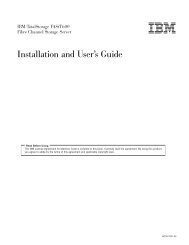Addressing OLTP Solutions with CICS: The Transaction Server ... - Ibm
Addressing OLTP Solutions with CICS: The Transaction Server ... - Ibm
Addressing OLTP Solutions with CICS: The Transaction Server ... - Ibm
Create successful ePaper yourself
Turn your PDF publications into a flip-book with our unique Google optimized e-Paper software.
3.2 Implementation<br />
3.2.1 Components<br />
28 <strong>CICS</strong> for AIX as the <strong>Transaction</strong> <strong>Server</strong><br />
be read only once. Transient data is used for queued data such as an audit<br />
trail and output for a printer.<br />
Temporary storage queue names do not have to be previously defined, and<br />
they can be updated in place. Temporary storage queues can be written to a<br />
file or to memory.<br />
For a more detailed description and comparison of these queue services,<br />
see <strong>CICS</strong> on Open Systems Application Programming Guide, SC33-1568-01.<br />
• Relational database services<br />
<strong>CICS</strong> provides access to relational databases that provide a programmable<br />
interface through SQL commands in either COBOL, C, or PL/1. Provided that<br />
the relational database management system (RDBMS) is compliant <strong>with</strong> the<br />
X/Open XA interface, it is possible to use two-phase commit processing<br />
between the resources coordinated by <strong>CICS</strong>. See section Chapter 7,<br />
“Interactions <strong>with</strong> the DB2 Family of Products” on page 85 for more details<br />
about processing <strong>with</strong> DB2.<br />
• Journal services<br />
<strong>CICS</strong> provides facilities for creating and maintaining journals during <strong>CICS</strong><br />
processing. A journal is a set of special-purpose sequential files. An<br />
application can use a journal as an audit trail to record which users<br />
submitted which transactions or which users accessed which records in a<br />
file, for example.<br />
In this section we provide an introduction to the structure of a <strong>CICS</strong> for AIX<br />
region. We do not provide a detailed explanation of the internals of <strong>CICS</strong> for<br />
AIX.<br />
A <strong>CICS</strong> for AIX region consists of:<br />
• A set of program executables, that is, the system code required for the<br />
product, including the necessary <strong>CICS</strong>, Encina, and DCE code<br />
• A file structure that contains definitions for the region, servers, clients, and a<br />
number of run-time files. <strong>The</strong> definitions are used to configure the system.<br />
<strong>The</strong> files holding each set of definitions are referred to as stanzas. <strong>The</strong><br />
run-time files contain such items as the message log, warm-start definitions,<br />
and recovery log.<br />
• A set of application programs provided by the enterprise that will perform<br />
the required business processing<br />
• User data, which may be held in an Encina SFS, in a database, or on a<br />
remote system<br />
See the <strong>CICS</strong> for AIX Planning and Installation Guide, GC33-1773-00, for more<br />
information about the directory structure of the regions, servers, and clients.<br />
<strong>The</strong> major components of <strong>CICS</strong> for AIX are:<br />
• <strong>The</strong> <strong>CICS</strong> client processes that you use to attach to a region and through<br />
which you run transactions<br />
• <strong>The</strong> transaction scheduler, a process that receives requests to run<br />
transactions, prioritizes and schedules them, and then dispatches them to an<br />
application server for processing
















